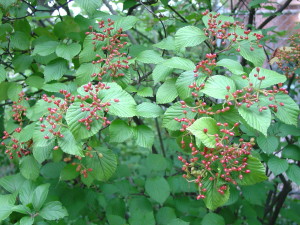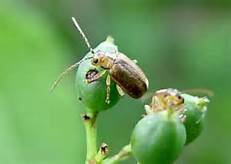Viburnum Leaf Beetle is gradually coming to the Southeastern U.S. It was first found in upstate New York in 1996. This pest has been on the move, eating its way through native viburnums from upstate New York to northern Pennsylvania to western Maryland.
It feeds only on viburnum species. Preferred species include native arrowwood viburnum (V. dentatum), European cranberrybush viburnum (V. opulus), American cranberrybush viburnum (V. trilobum), and Rafinesque viburnum (V. rafinesquianum). Other viburnums that also serve as hosts include Sargent viburnum (V. sargentii), wayfaringtree viburnum (V. lantana), nannyberry viburnum (V. lentago), and blackhaw viburnum (V. prunifolium).
This insect overwinters as clusters of eggs inside pencil-sized twigs, essentially killing these small twigs on edge of branches. Affected shrubs leaf out from lower buds and infest new pencil-sized shoots in spring. The larvae skeletonize the leaves and can completely defoliate plants by mid-June. Larvae drop off the shrubs, pupate and emerge as adults.
From July through September the adults do minor feeding, lay eggs and repeat the cycle. Each year viburnums decline from repeated infestations and die after 3 to 5 years of defoliation and egg-laying damage. Viburnum beetle is pretty easy to kill with insecticides containing either pyrethroid, carbaryl, or acephate (Orthene®), targeting larvae and adult stages. Unfortunately, spray applications of pesticides do not protect shrubs from egg-laying adults that may fly in from untreated areas during July through September.
Another treatment approach is to inject or drench the soil around the susceptible shrub with imidacloprid (Merit® or Bayer Advanced Garden Insecticide®) in late fall. This will protect shrubs from the larval feeding in the spring.
According to Research Entomologists at Michigan State University, these viburnum species are highly resistant: Koreanspice viburnum (V. carlesii), Burkwood viburnum (V. burkwoodii), doublefile viburnum (V. plicatum var. tomentosum), Judd viburnum (V. x juddii), lantanaphyllum viburnum (V. x rhytidiphylloides), and leatherleaf viburnum (V. rhytidiphyllum).



 Posted in
Posted in 
